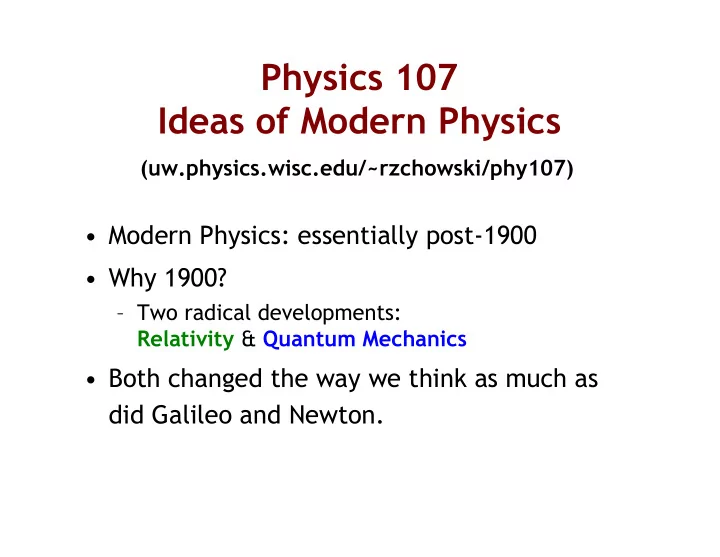

Physics 107 Ideas of Modern Physics (uw.physics.wisc.edu/~rzchowski/phy107) • Modern Physics: essentially post-1900 • Why 1900? – Two radical developments: Relativity & Quantum Mechanics • Both changed the way we think as much as did Galileo and Newton.
Goals of the course • Learn a process for critical thinking, and apply it to evaluate physical theories • Use these techniques to understand the ideas underlying modern physics. • Implement the ideas in some basic problems. • Learn where physics is today, and where it is going.
How is this done? • Read the textbook Physics Concepts & Connections • Come to the lectures 9:55 MWF in 1300 Sterling Hall • Participate in discussion section One per week, starting Sep. 13 • Do the homework Assigned each Wed, due the following Wednesday • Write the essay On a physics topic of your choice, due Dec. 6 • Take the exams Three in-class hour exams, one cumulative final exam
What will we cover? • Scientific observation and reasoning. • Motion and energy. • Relativity. • Quantum Mechanics. • Gravity. • Particle theory and cosmology.
Single atoms and quantum waves Entire galaxies
Where’s the math? • Math is a tool that can often help to clarify physics. • In this course we use algebra, and basic geometry and trigonometry. • We will do calculations, but also focus on written explanation and reasoning.
What do you get? • An understanding of the physical universe. • A grade – 15% HW – 15% essay – 20% each for 2 of 3 hour exams (lowest dropped) – 30% from cumulative final exam
A theory of the universe • Look around - what you see is the universe. • What can you say about how it works?
What Aristotle saw Air Water Earth
Earth, air, water, fire… • For terrestrial objects …and aether, from which celestial bodies are formed
Aristotle’s ideas about motion • Earth moves downward, Water downward, air rises up, fire rises above air. Straight-line motion • Celestial bodies have a perfectly circular motion.
Motion of the celestial bodies Apparent motion of stars: Rotation about a point every 24 hours. Moon, sun, and planets were known to move with respect to the stars.
Motion of the stars over 6 hrs
Daily motion of sun & planets over 1 year Movie by R. Pogge, Ohio State
Aristotle’s crystal spheres Earth/Water Air Fire Prime mover (24 hrs) Cristal sphere (49000 yrs) Firmament (1000 yrs) Saturn (30 years) Jupiter (12 years) Mars (2 years) Sun (1 yr) Venus (1 yr) Mercury (1 yr) Moon (28 days)
Detailed Observations of planetary motion (Ptolemy) Observational notes from Ptolemy’s Almagest
Retrograde planetary motion Retrograde motion of Mars Apparent motion not always in a straight line. Mars appears brighter during the retrograde motion.
Epicycles, deferents, and equants: the legacy of Ptolemy Epicycle reproduced planetary retrograde motion
Ptolemy’s universe • In ‘final’ form – 40 epicycles and deferents – Equants and eccentrics for sun, moon, and planets. – Provided detailed planetary positions for 1500 years
More detailed observations, + some philosophy (Copernicus) • Ptolemy’s system worked, but seemed a little unwieldy, contrived. • Imperfect circular motion against Aristotle. • Copernicus revived heliocentric universe – Retained epicycles (for detailed predictions) – Used only perfect circular motion
The heliocentric universe • Sun-centered • Planets orbiting around sun. • Planets still on epicycles (not shown). • But the (imperfect) theory is attractive in several ways.
Advantage: “Natural” explanation of Retrograde motion Retrograde motion observed as planets pass each other.
Advantage: A ‘good’ theory makes predictions half-illuminated Venus Planet Copernicus Actual Mercury 0.376 0.387 Venus 0.719 0.723 Earth 1.00 1.00 Mars 1.52 1.52 Jupiter 5.22 5.20 Earth Saturn 9.17 9.54
How can we tell if it is ‘correct’? A Rotating and Revolving Earth seems absurd: Both motions require very large speeds: * Speed of rotation ~ 1280 km/hour * Orbital Speed: 107,000 km/hr = 30 km/sec! There is no observational evidence of orbital motion: * Stellar Parallaxes were not observed. * Stars weren't brighter at opposition. There is no observational evidence of rotation: * Daily motions are as easily explained by a fixed earth. * The motions do not require a rotating earth.
20 years of detailed observations (Brahe & Kepler) • Brahe’s exacting observations demanded some dramatic revisions in planetary motions. • Contribution of Kepler: – first consideration of non- circular orbits in over 1000 yrs of thinking. – Detailed relations for orbital motions.
Kepler’s elliptical orbits
Kepler and geometry • Like most scientists, Kepler’s studies were wide-ranging. • Focused on shaped and symmetry of actual objects and motion.
Kepler’s ‘wrong’ idea
Some common threads • More detailed observations test, and sometimes force changes to theories. • ‘Philosophical’ considerations, such as complexity and symmetry, can lead to revolutionary developments. • Thoughtful consideration of possibilities that at first seem outrageous We will see this throughout the course: In relativity, in quantum mechanics, and in particle field theories.
An important difference • ‘Ancient’ theories focused on description of motion, empirical laws, without answering ‘why?’ • Symmetries were of shape and motion. • Later developments focus on the physical laws that govern motion. • The actual motion can be quite complex, but the physical laws demonstrate astounding simplicity, beauty, and symmetry.
Next week • No class Monday, Sep. 6 (Labor Day) • No discussion sections next week (start Sep. 13 & 14). • Next week start Chapter 3, How things move
Recommend
More recommend